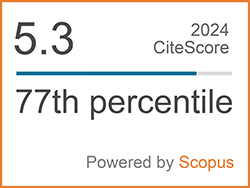Microwave Synthesis of Butyl Levulinate Using a Keggin Heteropolyacid from Eichhornia crassipes Cellulose Obtained by Pretreatment with Bacillus sp.
Abstract
Keywords
[1] R. Sindhu, P. Binod, A. Pandey, A. Madhavan, J. A. Alphonsa, N. Vivek, E. Gnansounou, E. Castro, and V. Faraco, “Water hyacinth a potential source for value addition: An overview,” Bioresource Technology, vol. 230, pp. 152–162, 2017, doi: 10.1016/j.biortech.2017. 01.035.
[2] K. Amulya, “Aquatic biomass as sustainable feedstock for biorefineries,” Biofuels, Bioproducts and Biorefining, vol. 17, no. 4, p. 1012–1029, 2023, doi: 10.1002/bbb.2471.
[3] E. O. Babatunde, R. Gurav, and S. Hwang, “Recent advances in invasive aquatic plant biomass pretreatments for value addition,” Waste and Biomass Valorization, vol. 14, no. 11, pp. 3503–3527, 2023, doi: 10.1007/s12649-023-02186-5.
[4] N. Yamanaka and S. Shimazu, “Conversion of biomass-derived molecules into alkyl levulinates using heterogeneous catalysts,” Reactions, vol. 4, no. 4, pp. 667–678, 2023, doi: 10.3390/reactions 4040038.
[5] A. M. R. Galletti, C. Antonetti, S. Fulignati, and D. Licursi, “Direct alcoholysis of carbohydrate precursors and real cellulosic biomasses to alkyl levulinates: A critical review,” Catalysts, vol. 10, no. 10, pp. 1–2, 2020, doi: 10.3390/catal10101221.
[6] D. D. M. D. Bucchianico, Y. Wang, J.-C. Buvat, Y. Pan, V. C. Moreno, and S. Leveneur, “Production of levulinic acid and alkyl levulinates: A process insight,” Green Chemistry, vol. 24, pp. 614–646, 2022, doi: 10.1039/D1GC02457D.
[7] S. Zhao, G. Xu, C. Chang, S. Fang, Z. Liu, and F. Du, “Direct conversion of carbohydrates into ethyl levulinate with potassium phosphotungstate as an efficient catalyst,” Catalysts, vol. 5, no. 4, pp. 1897–1910, 2015, doi: 10.3390/catal5041897.
[8] P. F. Pinheiro, D. M. Chaves, and M. J. da Silva, “One-pot synthesis of alkyl levulinates from biomass derivative carbohydrates in tin(II) exchanged silicotungstates-catalyzed reactions,” Cellulose, vol. 26, no. 13–14, pp. 7953–7969, 2019, doi: 10.1007/s10570-019-02665-w.
[9] K. Garves, “Acid catalyzed degradation of cellulose in alcohols,” Journal of Wood Chemistry and Technology, vol. 8, no. 1, pp. 121–134, 1988, doi: 10.1080/02773818808070674.
[10] Y. Piñeros-Castro, Aprovechamiento de Biomasa Lignocelulósica, Algunas Experiencias de Investigación En Colombia. Bogotá: Universidad Jorge Tadeo Lozano, 2014, doi: 10.2307/j.ctv2rcnqc5.
[11] Y. Su, C. Liu, H. Fang, and D. Zhang, “Bacillus subtilis: A universal cell factory for industry, agriculture, biomaterials and medicine,” Microbial Cell Factories, vol. 19, no. 1, pp. 1–12, 2020, doi: 10.1186/s12934-020-01436-8.
[12] L. Westers, H. Westers, and W. J. Quax, “Bacillus subtilis as cell factory for pharmaceutical proteins: A biotechnological approach to optimize the host organism,” Biochimica et Biophysica Acta - Molecular Cell Research, vol. 1694, no. 1–3, pp. 299–310, 2004, doi: 10.1016/j.bbamcr.2004.02.011.
[13] J. C. Zweers, I. Barák, D. Becher, A. J. M. Driessen, M. Hecker, V. P. Kontinen, M. J. Saller, L. Vavrová, and J. M. Dijl, “Towards the development of Bacillus subtilis as a cell factory for membrane proteins and protein complexes,” Microbial Cell Factories, vol. 7, pp. 1–20, 2008, doi: 10.1186/1475-2859-7-10.
[14] R. B. Simonetti, “Effect of biological pretreatment of water hyacinth on enzymatic hydrolysis for bioethanol production,” Asian Journal of Chemistry, vol. 26, no. 18, pp. 1–6, 2014, doi: 10.14233/ajchem.2014.16596.
[15] A. Jongmeesuk, V. Sanguanchaipaiwong, and D. Ochaikul, “Pretreatment and enzymatic hydrolysis from water hyacinth (Eichhornia crassipes),” KMITL Science and Technology Journal, vol. 14, no. 2, pp. 79–86, 2014.
[16] Z. Zhang, A. M. Shah, H. Mohamed, N. Tsiklauri, and Y. Song, “Isolation and screening of microorganisms for the effective pretreatment of lignocellulosic agricultural wastes,” BioMed Research International, vol. 2021, 2021, doi: 10.1155/2021/5514745.
[17] A. Das, P. Ghosh, T. Paul, U. Ghosh, B. R. Pati, and K. C. Mondal, “Production of bioethanol as useful biofuel through the bioconversion of water hyacinth (Eichhornia crassipes),” 3 Biotech, vol. 6, no. 1, pp. 1–9, 2016, doi: 10.1007/s13205-016-0385-y.
[18] V. B. Barua, V. V Goud, and A. S. Kalamdhad, “Microbial pretreatment of water hyacinth for enhanced hydrolysis followed by biogas production,” Renewable Energy, 2018, doi: 10.1002/ep.12683.
[19] W. Song, J. Cheng, L. Ding, M. Liu, J. Zhou, and K. Cen, “Improving fermentative hydrogen production from water hyacinth with genetically modified bacteria,” Environmental Progress & Sustainable Energy, vol. 36, pp. 1296–1300, 2017, doi: 10.1002/ep.12683.
[20] K. T. Nguyen, T. Hong, N. Lai, and T. Da Nguyen, “Polyhydroxybutyrate accumulation of Bacillus sp. strains using water hyacinth hydrolysate as a carbon source,” Tap Chi Sinh Hoc, vol. 44, no. 3, pp. 35–45, 2022, doi: 10.15625/2615-9023/16887.
[21] E. C. Alvarez and L. C. Sánchez, “Evaluation of growth of four species of the genus Bacillus sp., the first step to understand their biocontrol effect on Fusarium sp.,” Nova, vol. 14, no. 26, pp. 53–62, 2016.
[22] M. Garriga, M. Almaraz, and A. Marchiaro, “Determination of reducing sugars in extracts of Undaria pinnatifida (harvey) algae by UV-visible spectrophotometry (DNS method),” Actas de Ingeniería, vol. 3, no. 1, pp. 173–1179, 2017.
[23] Y. Yue, J. Han, G. Han, G. M. Aita, and Q. Wu, “Cellulose fibers isolated from energycane bagasse using alkaline and sodium chlorite treatments: Structural, chemical and thermal properties,” Industrial Crops and Products, vol. 76. pp. 355–363, 2015, doi: 10.1016/j.indcrop.2015.07.006.
[24] M. L. Nelson and R. T. O’connor, “Relation of certain infrared bands to cellulose crystallinity and crystal lattice type. Part II. A new infrared ratio for estimation of crystallinity in celluloses I and II,” Journal of Applied Polymer Science, vol. 8, no. 1, pp. 1325–1341, 1964, doi: 10.1002/app.1964.070080323.
[25] F. C. Navarrete, “Caracterización estructural de fibras Lyocell y su comportamiento frente a procesos de degradación,” tdx.cat. http://www.tdx.cat/TDX-0905102-142432 (accessed Jun. 3, 2002).
[26] R. G. Saratale, S.-K. Cho, G. S. Ghodake, H.-S. Shin, G. D. Saratale, Y. Park, H.-S. Lee, R. N. Bharagava, and D.-S. Kim, “Utilization of noxious weed water hyacinth biomass as a potential feedstock for biopolymers production: A novel approach,” Polymers, vol. 12, no. 8, 2020, doi: 10.3390/POLYM12081704.
[27] Y. Zhang, X. Wang, T. Hou, H. Liu, L. Han, and W. Xiao, “Efficient microwave-assisted production of biofuel ethyl levulinate from corn stover in ethanol medium,” Journal of Energy Chemistry, vol. 27, no. 3, pp. 890–897, 2018, doi: 10.1016/j.jechem.2017.06.010.
[28] J. Rajendhran, V. Krishnakumar, and P. Gunasekaran, “Production of penicillin G acylase from Bacillus sp.: Effect of medium components,” World Journal of Microbiology and Biotechnology, vol. 19, no. 1, pp. 107–110, 2003, doi: 10.1023/A:1022512217095.
[29] C. E. D. S. Teodoro and M. L. L. Martins, “Culture conditions for the production of thermostable amylase by Bacillus sp,” Brazilian Journal of Microbiology, vol. 31, no. 4, pp. 298–302, 2000, doi: 10.1590/s1517-83822000000400011.
[30] C. Cabrera and C. Novoa, “Influence of concentration and fermentation temperature of reducing sugars obtained from sugarcane bagasse’s hydrolyzate, in obtaining a biopolymer using Bacillus subtilis,” Agroindustrial Science, vol. 1, pp. 17–28, 2016, doi: 10.17268/agroind. science.2016.01.02.
[31] E. Y. Kwon, K. M. Kim, M. K. Kim, I. Y. Lee, and B. S. Kim, “Production of nattokinase by high cell density fed-batch culture of Bacillus subtilis,” Bioprocess and Biosystems Engineering, vol. 34, no. 7, pp. 789–793, 2011, doi: 10.1007/ s00449-011-0527-x.
[32] V. L. Gray, C. T. Müller, I. D. Watkins, and D. Lloyd, “Peptones from diverse sources: Pivotal determinants of bacterial growth dynamics,” Journal of Applied Microbiology, vol. 104, no. 2, pp. 554–565, 2008, doi: 10.1111/j.1365-2672. 2007.03577.x.
[33] N. Kujawska, S. Talbierz, M. Dębowski, J. Kazimierowicz, and M. Zieliński, “Optimizing docosahexaenoic acid (Dha) production by schizochytrium sp. grown on waste glycerol,” Energies, vol. 14, no. 6, pp. 1–17, 2021, doi: 10.3390/en14061685.
[34] F. Cheng, H. Chen, N. Lei, M. Zhang, and H. Wan, “ Effects of carbon and nitrogen sources on activity of cell envelope proteinase produced by Lactobacillus plantarum LP69 ,” Acta Universitatis Cibiniensis. Series E: Food Technology, vol. 23, no. 1, pp. 11–18, 2019, doi: 10.2478/aucft-2019-0002.
[35] T. A. Pham, T. P. Nguyen, and K. A. To, “Improvement of Bacillus clausii HH1 cell density via culture medium optimization and pH-stat fed batch fermentation,” Vietnam Journal of Science and Technology, vol. 61, no. 4, pp. 590–598, 2023, doi: 10.15625/2525-2518/17250.
[36] W. Li, M. X. Jia, J. Deng, J. H. Wang, Q. L. Lin, C. Liu, S. S. Wang, J. X. Tang, X. X. Zeng, L. Ma, W. Su, X. Y. Liu, F. Cai, and L. Y. Zhou, “Isolation, genetic identification and degradation characteristics of COD-degrading bacterial strain in slaughter wastewater,” Saudi Journal of Biological Sciences, vol. 25, no. 8, pp. 1800–1805, 2018, doi: 10.1016/j.sjbs.2018.08.022.
[37] M. B. E. Turbay, G. S. D. Giori, and E. M. Hebert, “Release of the cell-envelope-associated proteinase of Lactobacillus delbrueckii subspecies lactis CRL 581 is dependent upon pH and temperature,” Journal of Agricultural and Food Chemistry, vol. 57, no. 18, pp. 8607–8611, 2009, doi: 10.1021/jf901531q.
[38] N. Bansal, R. Soni, C. Janveja, and S. K. Soni, “Production of xylanase-cellulase complex by Bacillus subtilis NS7 For the biodegradation of agro-waste residues,” Lignocellulose, vol. 3, no. 1, pp. 196–209, 2013.
[39] H. P. Uwamahoro, F. Li, A. Timilsina, B. Liu, X. Wang, and Y. Tian, “ An assessment of the lactic acid-producing potential of bacterial strains isolated from food waste,” Microbiology Research, vol. 13, no. 2, pp. 278–291, 2018, doi: 10.3390/ microbiolres13020022.
[40] Z. Yan, X. W. Zheng, J. Y. Chen, J. S. Han, and B. Z. Han, “Effect of different Bacillus strains on the profile of organic acids in a liquid culture of Daqu,” Journal of the Institute of Brewing, vol. 119, no. 1–2, pp. 78–83, 2013, doi: 10.1002/jib.58.
[41] P. Calvo and D. Zúñiga, “Caracterización fisiológica de cepas de Bacillus spp. aisladas de la rizósfera de papa (Solanum tuberosum),” Ecología Aplicada, vol. 9, no. 1–2, p. 31, 2010, doi: 10.21704/rea.v9i1-2.393.
[42] S. Shukla, T. B. Choi, H. K. Park, M. Kim, I. K. Lee, and J. K. Kim, “Determination of non-volatile and volatile organic acids in Korean traditional fermented soybean paste (Doenjang),” Food and Chemical Toxicology, vol. 48, no. 8–9. pp. 2005–2010, 2010. doi: 10.1016/j.fct.2010.04.034.
[43] J. Snay, J. W. Jeong, and M. M. Ataai, “Effects of growth conditions on carbon utilization and organic by‐product formation in B. subtilis,” Biotechnology Progress, vol. 5, no. 2. pp. 63–69, 1989. doi: 10.1002/btpr.5420050207.
[44] A. G. Franco, P. N. M. Yepez, and H. A. V. Sánchez, “Biomass and cellulose pretreatments for saccharification,” Scientia et Technica, vol. 15, no. 42, pp. 284–289, 2009.
[45] K. Ospino, E. Gómez, and L. Rios, “Evaluación de técnicas de pretratamiento en buchón de agua (Eichhornia crassipes) para la producción de bioetanol,” Información Tecnológica, vol. 31, no. 1, pp. 215–226, 2020, doi: 10.4067/s0718-07642020000100215.
[46] K. Rop, D. Mbui, G. N. Karuku, I. Michira, and N. Njomo, “Characterization of water hyacinth cellulose-g-poly(ammonium acrylate-co-acrylic acid)/nano-hydroxyapatite polymer hydrogel composite for potential agricultural application,” Results in Chemistry, vol. 2, 2020, doi: 10.1016/j.rechem.2019.100020.
[47] X. Ju, M. Bowden, E. E. Brown, and X. Zhang, “An improved X-ray diffraction method for cellulose crystallinity measurement,” Carbohydrate Polymers, vol. 123, pp. 476–481, 2015, doi: 10.1016/j.carbpol.2014.12.071.
[48] A. D. Bhetalu, N. V. L. NV, S. S. Patil, and N. W. Ingole, “X-ray diffraction studies during dilute acid pretreatment of lignocellulosic biomass.,” International Journal of Universal Print, vol. 4, no. 07, pp. 433–438, 2018.
[49] B. Sulbarán-Rangel, J. Jouvenson, J. Barrera-Rojas, H. Palacios-Hinestroza, and K. J. Gurubel Tun, “Valorization of water hyacinth after organosolv fractionation: Cellulose fiber and anaerobic digestion,” Waste and Biomass Valorization, vol. 15, no. 3, pp. 1–11, 2023, doi: 10.1007/s12649-023-02229-x.
[50] C. Xu, F. Ma, X. Zhang, and S. Chen, “Biological pretreatment of corn stover by Irpex lacteus for enzymatic hydrolysis,” Chem Food, pp. 10893–10898, 2010, doi: 10.1021/jf1021187.
[51] N. Akhtar, A. Sharma, D. Deka, M. Jawed, D. Goyal, and A. Goyal, “Characterization of cellulase producing Bacillus sp. for effective degradation of leaf litter biomass,” Environmental Progress & Sustainable Energy, vol. 32, no. 4, pp. 1195–1201, 2013, doi: 10.1002/ep.11726.
[52] C. A. Pena, A. Soto, A. William, T. King, and H. Rodríguez, “Improved reactivity of cellulose via its crystallinity reduction by non-dissolving pretreatment with an ionic liquid,” ACS Sustainable Chemistry & Engineering, vol. 7, no. 10, 2019, doi: 10.1021/acssuschemeng.8b06357.
[53] Y. Liu, Q. Zhong, S. Wang, and Z. Cai, “Correlating physical changes and enhanced enzymatic saccharification of pine flour pretreated by N -Methylmorpholine- N -oxide,” Biomacromolecules, vol. 12, no. 7, pp. 2626–2632, 2011, doi: 10.1021/bm2004302.
[54] G. Jäger, M. Girfoglio, F. Dollo, R. Rinaldi, H. Bongard, U. Commandeur, R. Fischer, A. C. Spiess, and J. Büchs, “How recombinant swollenin from Kluyveromyces lactis affects cellulosic substrates and accelerates their hydrolysis,” Biotechnology for Biofuels and Bioproducts, vol. 4, no. 3, pp. 20–24, 2011. doi: 10.1186/1754-6834-4-33
[55] H. B. Ajuna, H. I. Lim, J. H. Moon, S. J. Won, V. Choub, S. I. Choi, J. Y. Yun, and Y. S. Ahn, “The prospect of hydrolytic enzymes from Bacillus species in the biological control of pests and diseases in forest and fruit tree production,” International Journal of Molecular Sciences, vol. 24, no. 23, 2023, doi: 10.3390/ijms242316889.
[56] J. L. Palomino, “Evaluación de la capacidad de degradación de residuos agrícolas utilizando bacterias celuloliticas y xilanoliticas, como alternativas de tecnología limpia,” repositorio.unasam.edu.pe. http://repositorio.unasam.edu.pe/handle/UNASAM/2012 (accessed Mar. 27, 2018).
[57] F. Mannai, H. Elhleli, M. Ammar, R. Passas, E. Elaloui, and Y. Moussaoui, “Green process for fibrous networks extraction from Opuntia (Cactaceae): Morphological design, thermal and mechanical studies,” Industrial Crops and Products, vol. 126, pp. 347–356, 2018, doi: 10.1016/j.indcrop.2018.10.033.
[58] R. Sindhu, M. Kuttiraja, P. Binod, R. K. Sukumaran, and A. Pandey, “Physicochemical characterization of alkali pretreated sugarcane tops and optimization of enzymatic saccharification using response surface methodology,” Renewable Energy, vol. 62, pp. 362–368, 2014, doi: 10.1016/j.renene.2013.07.041.
[59] K. K. Packiam, B. Murugesan, P. M. Kaliyannan Sundaramoorthy, H. Srinivasan, and K. Dhanasekaran, “Extraction, purification and characterization of nanocrystalline cellulose from Eichhornia crassipes (Mart.) Solms: A common aquatic weed water hyacinth,” Journal of Natural Fibers, vol. 19, no. 14, pp. 7424–7435, 2022, doi: 10.1080/15440478.2021.1946886.
[60] N. Grijalva, “Degradación de residuos vegetales mediante inoculación con cepas microbianas,” Enfoque UTE, vol. 1, pp. 1–13, 2013.
[61] A. G. Rodríguez, F. A. Colmenares, J. C. Barragán, and M. A. Mayorga, “Aprovechamiento energético integral de la Eichhornia crassipes (Buchón de agua),” Ingenium, vol. 18, pp. 134–151, 2017, doi: 10.21500/01247492.3219.
[62] L. A. Ríos, “Producción de bioetanol a partir de jacinto de agua (Eichhornia crassipes) respecto a otros materiales lignocelulósicos,” Revista Agunkuyâa, vol. 2, no. 1, 2012.
[63] V. B. Barua and A. S. Kalamdhad, “Effect of various types of thermal pretreatment techniques on the hydrolysis, compositional analysis and characterization of water hyacinth,” Bioresource Technology, vol. 227, pp. 147–154, 2017, doi: 10.1016/j.biortech.2016.12.036.
[64] A. Mandal and D. Chakrabarty, “Isolation of nanocellulose from waste sugarcane bagasse (SCB) and its characterization,” Carbohydrate Polymers, vol. 86, pp. 1291– 1299, 2011, doi: 10.1016/j.carbpol.2011.06.030.
[65] T. Istirokhatun, N. Rokhati, R. Rachmawaty, M. Meriyani, S. Priyanto, and H. Susanto, “Cellulose isolation from tropical water hyacinth for membrane preparation,” Procedia Environmental Science, vol. 23, pp. 274–281, 2015, doi: 10.1016/j.proenv.2015.01.041.
[66] Y. Wang, J. Shi, X. Chen, M. Chen, J. Wang, and J. Yao, “Ethyl levulinate production from cellulose conversion in ethanol medium over high-efficiency heteropoly acids,” Fuel, vol. 324, 2022, Art. no. 124642, doi: 10.1016/j.fuel. 2022.124642.
[67] R. E. Quiroz-Castañeda, N. Pérez-Mejía, C. Martínez-Anaya, L. Acosta-Urdapilleta, and J. Folch-Mallol, “Evaluation of different lignocellulosic substrates for the production of cellulases and xylanases by the basidiomycete fungi Bjerkandera adusta and Pycnoporus sanguineus,” Biodegradation, vol. 22, no. 3, pp. 565–572, 2011, doi: 10.1007/s10532-010-9428-y.
[68] D. Qin, Y. Liu, R. Yang, J. Li, and C. Hu, “Complete low-temperature transformation and dissolution of the three main components in corn straw,” Chemistry Open, vol. 12, no. 2, 2023, Art. no. e202200247, doi: 10.1002/open.202200247.
[69] L. Peng, H. Li, L. Xi, K. Chen, and H. Chen, “Facile and efficient conversion of furfuryl alcohol into n -butyl levulinate catalyzed by extremely low acid concentration,” Bioresources, vol. 9, no. 3, pp. 3825–3834, 2014.
[70] H. Guo, Y. Zhao, X. Chen, Q. Shao, and W. Qin, “Pretreatment of Miscanthus with biomass-degrading bacteria for increasing delignification and enzymatic hydrolysability,” Microbial Biotechnology, vol. 12, no. 4, pp. 787–798, 2019, doi: 10.1111/1751-7915.13430.
[71] S. Tanpichai, S. K. Biswas, S. Witayakran, and H. Yano, “Water hyacinth: A sustainable lignin-poor cellulose source for the production of cellulose nano fibers,” ACS Sustainable Chemistry & Engineering, vol. 7, no. 23, pp. 18884–18893, 2019, doi: 10.1021/acssuschemeng. 9b04095.
DOI: 10.14416/j.asep.2025.01.004
Refbacks
- There are currently no refbacks.
 Applied Science and Engineering Progress
Applied Science and Engineering Progress







